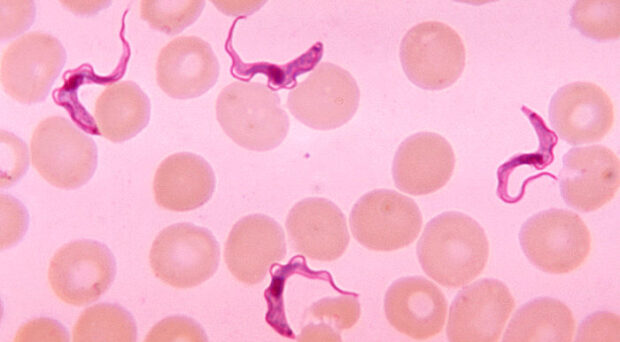
The group of neglected tropical diseases caused by single celled, flagellate parasites (the trypanosomatids) include Chagas disease, human African sleeping sickness and leishmaniasis. Progress on the improvement of the treatment of these diseases had been slow, though large chemical library screens for potential new drugs are now showing promising results.
One such study has recently been published in Science. This multiauthor paper describes the identification of a class of compounds that rapidly kill trypanosomes, and explores their mode of action.
The trypanosomatids
These belong to a group of single celled organisms, known as kinetoplastids, that are distinguished by the possession of one or two flagella and a DNA-containing structure, the kinetoplast, that is in addition to the nucleus. The trypanosomatids have a single flagellum, and all are parasitic. Most of them infect insects and some have a two-host life cycle. Species that use humans as a second host include Trypanosoma cruzi (transmitted by triatomine bugs), Trypanosoma brucei (transmitted by tsetse flies), and species of Leishmania (transmitted by sandflies). These are responsible for causing Chagas disease, human African trypanosomiasis or HAT (sleeping sickness) and leishmaniasis respectively.
Identification of compounds with trypanocidal activity
With the help of automation and miniaturisation techniques, Shrinivasa Rao and colleagues performed whole-cell high-throughput screening of the Novartis compound collection with cultures of the blood stages of trypanosomes. They identified cyanotriazole0 (CT0), a compound belonging to the cyanotriazole (CT) group that subsequently proved to be potent growth inhibitors of other trypanosmonatids as well, but not of a range of other microbial pathogens.
Despite its cytocidal activity, the properties of CT0 would be problematic for use in vivo as it has limited solubility and poor oral bioavailability and brain exposure. The latter being a particular issue in second stage HAT when the parasites invade the central nervous system. The group successively combated these problems by modifying the scaffold of the molecule to produce CT1 and CT3, which were suitable for in vivo assessment.
Initially, in vitro experiments optimised the drug dose for speed of action and potency. It was particularly important that parasites could be eliminated completely in the case of Chagas disease, to avoid return of the disease.
CT3 was then tested in a bioluminescence mouse model for Chagas disease. No parasites could be detected after three rounds of treatment, even in immunosuppressed mice. Extraction and examination of organs confirmed this. Remarkably, the effectiveness of CT3 was also assessed in a mouse model for HAT, where single-dose clearance of parasites was achieved for stage II HAT and ex vivo examination of brains showed complete clearance of parasites.
The mechanism of action of CT3
The group used several approaches to determine the mode of action of CT1 and CT3.
- Observation of the cell cycle of T. b. brucei (this causes nagana or animal tryanosomiasis) and T. cruzi showed that DNA replication in the nucleus, but not the kinetoplast, was inhibited. Study of the metabolomics of CT3 treated trypanosomes showed a large increase in deoxynucleotide abundance. Was this due to DNA damage occurring?
- Immunoblotting and in situ fluorescent microscopy did reveal an increase in double-stranded DNA breaks.
- Several b. brucei that were CT drug-resistant mutants were selected and whole-genome sequencing identified a single-nucleotide polymorphism in the topoisomerase II alpha gene (topoIIα) that was common to all mutants.
- There are two topoisomerase II enzymes in b. brucei, but only topoisomerase II alpha (TopoIIα) is needed for blood-stage survival. The identification of mutations in the topoIIα gene in CT resistant strains, plus other observations, led the group to conclude that this was the site of action of the CTs.
DNA topoisomerases: These enzymes unravel twists that occur in DNA during transcription and replication, converting supercoiled forms to relaxed forms and visa versa. They bind to the DNA and cut the sugar-phosphate backbone of one or two strands. Topoisomerase II poisons stabilize the covalent DNA:enzyme complex, which leads to dsDNA breaks as supercoiled forms cannot reform.
- To confirm this, one of the drug-resistant alleles was introduced into b. brucei using the CRISPR-Cas9 system. These parasites were highly resistance to CTs, confirming TopoIIα as the drug target.
- The group now synthesised the TopoII enzyme from cruzi, using a baculovirus expression system, and subjected it to a Topo2 cleavage assay, which measures the stabilization of dsDNA breaks. When CT1 or CT3 was added lineralised DNA accumulated, showing the CTs had stabilised the topoisomerase dsDNA cleavage complex, and the DNA could not return to a supercoiled form. By contrast the CTs did not affect human TOP2A cleavage activity.
- Finally, the group used cryo–electron microscopy to solve the structure of the cruziTopoII DNA binding domain bound to dsDNA and CT1
The future
This comprehensive research project has demonstrated that cyanotriazoles are selective topoisomerase II poisons. They effectively inhibit growth of kinetoplastid parasites in vitro, and act swiftly to eliminate the agents of Chagas disease and human African trypanosomiasis in mouse models.The group are working to identify suitable clinical candidates and are confident that their finding will help to improve the treatment of these neglected tropical diseases, a much-needed advance.

Comments